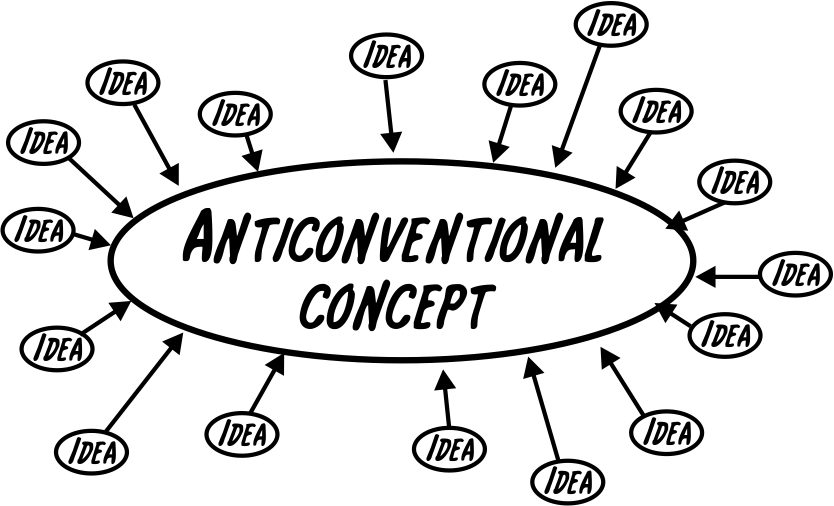The Anticonventional Thinking (ACT) Method (2.0)
by Jeffrey Baumgartner
I introduced the anticonventional thinking (ACT) about a year ago and presented it at the European Conference of Creativity and Innovation (ECCI) in 2011. Since then, I have presented it in workshops and have faciltated ACTings (ACT sessions). In doing so, I have realised that the method could be improved. In particular, the method needed simplification and clarity. Hence, I have rewritten the ACT whitepaper. Below is a description of the method.
ACT is a four-step process for generating creative, unconventional ideas to accomplish goals and then defining an initial action plan to implement the ideas.
1. Deconstruct and understand the situation.
2. Create a sexy goal.
3. Devise, debate and develop ideas.
4. Outline an action plan.
The process is specifically designed to trick the mind to take an unconventional approach to the situation and make it easy to generate creative ideas. The logic behind ACT is explained in the next chapter of this paper.
Step 1: Deconstruct the Situation
ACT starts with a problem or a goal, which we will call a “situation”. As tempted as you may be to start suggesting ideas the moment you think you have a problem, don’t! You will most likely only have conventional ideas. Instead, you need to deconstruct the situation in order to understand it better. You do this by asking open-ended questions. ACT provides questions in two categories. In addition, you can ask questions of your own devising.
- Understanding. These questions help you understand the situation better. They include: the Five Whys (see below).
- Context. These questions help you understand the context of the situation better, such as “By what criteria will we judge a potential solution?” and “Who needs to be involved in the implementation of the solution?”
The Five Whys1 is a simple yet powerful way to analyse a problem. Simply ask “Why is this a problem?” or “Why do I wish to achieve this goal?” once you have an answer, ask why again. Repeat until you have asked why five times – or cannot go deeper. You should always start your deconstruction with the five whys.
In addition to asking questions, you must also find answers to them. If you are not sure of an answer to a particular question and do not know where to find it, make up an answer. That will suffice.
Step 2: Create a Sexy Goal
Once you understand your situation and its context, you should formulate a sexy goal to shoot for. A sexy goal is:
- intriguing
- provocative
- desirable
Defining a sexy goal is important. As noted, a conventional goal encourages
conventional solutions. A well framed sexy goal motivates unconventional solutions.
Indeed, it makes coming up with creative ideas easy!
Sometimes sexy goals are obvious. If not, we can ask questions about the situation,
questions specifically designed to help reformulate your goal into a sexy one.
ACT provides a number of such questions, such as: “Can you formulate this
goal using a superlative?” and “Why is this goal boring/conventional?”
Step 3: Devise, Debate and Develop Ideas
Once you have your sexy goal set, the next step is to come up with creative, unconventional ideas. However, we do not want a long list of ideas or a whiteboard full of sticky-notes. Instead, the aim is to play with ideas, question them, debate them, reject ones that do not work and develop into bigger concepts the ones that do work.
In ACT you are encouraged to criticise ideas, especially boring ideas, but also ideas that you do not believe are viable. However, you must follow the rules of debate when ACTing (doing an ACT session). Indeed, I recommend you put these rules on the wall before you start.
Rules of Debate
- Always criticise boring ideas.
- Criticise the idea and not the person asking it.
- If you criticise an idea, you must allow the person who suggested it and anyone else to defend the idea.
In addition, if a participant of the session is higher in the corporate hierarchy
than the others, she must tell people that she expects to hear her ideas criticised
and will be disappointed if this does not happen.
Continue to ask questions about the sexy goal as well as the ideas proposed
during this part of the session. This helps stimulate imagination and encourages
the development of ideas.
At the end of step 3, you should have very few, very strong ideas. Often, you will have focused on one idea and will have developed it in some detail with additional ideas. For instance, if you are ACTing for a new floor cleaning product your company could introduce, you might explore a few ideas, such as odours or products for special floor types before you settle on a product that includes a mild insecticide to keep bugs away. If you feel this idea has potential, you start to focus on the features of the new product, perhaps the composition, dealing with safety issues and so on. If over time, this idea seems not to work, you would reject it – or put it aside – and explore other ideas.
This approach is very different to brainstorming. To illustrate, this is what you can expect from a brainstorm: a lot of ideas:

And this is what you can expect from ACTing, a big idea (or two or three) that incorporates many smaller ideas.

If you are familiar with brainstorming or working with people who are, you will
need to stress the differences between brainstorming and ACT. However, when
people get used to ACT, it will become very natural.
Non-Step: Evaluation
ACT aims to forgo evaluation. Ideally the devise, debate and develop ideas step will leave you with a concept to work with. However, in some cases you may have several ideas or an external committee which must review ideas. In this case, ideas are best evaluated by a pre-established criteria set. Moreover, these criteria should be communicated to the participants of the ACTing in advance so they can be considered throughout the process.
Step 4: Action Plan
# With any luck you will now have a creative, unconventional idea that you expect will enable you to achieve your sexy goal. It would be very easy to stop here and bask in the glory of your creativity! Don’t! You need to outline an action plan that can bring your brilliant idea to fruition.
My friend and creativity expert Fernando Cardoso de Sousa has developed a wonderful and simple approach to outlining a preliminay action plan. Simply ask the ASKing team to to prepare a WASNT (What Are the Steps Needed To) document for the idea. For example, let us imagine that the sexy new product solution is to build a mobile telephone into a pair of rings, one worn on the thumb and the other on the pinky so that people can make phone calls using only their hands. You would then ask: “What are the steps needed to realise our dual-ring-phone?” Then you would build a list of steps that might include:
- Build a mock-up to sell internally
- Build a prototype to test technically
- Present prototype to marketing
- And so on...
However, in real life the list would be more detailed. Assigning people to
take charge of each task is also important. The WASNT document is not a project
outline. It is simply a proposed action plan to get started. Indeed, in many
cases, the first step will be to prepare a detailed project outline.
Innovation and Risk
In the corporate world, highly creative ideas suffer several handicaps. Two of them should concern you while drafting the action plan. Firstly, highly creative ideas are risky. Secondly, as a result of that riskiness, they can often be difficult to sell to decision makers be they individuals or committees.
A breakthrough innovation could transform your company. It could turn a floundering company into a market leader; it could turn an annual loss into an annual profit. But it could also fail miserably. There are all kinds of reasons for this. The technology may be more complex than you realise, the need may not exist in the marketplace. You may be too far ahead of your time. Your customers may simply be too conservative in their preferences. For example, from a technical perspective, probably the most innovative American car manufacturer ever was Cord Automobile. In the 1930s, Cord’s strategy was to build unique, innovative cars. And they did! But, before the 1930s was out, the company was out of business. It seems that people did not want such innovative cars at the time.
Decision makers tend to be risk adverse and, as a result, may be quick to try and kill off a very creative idea in spite of its potential for innovation. Worse, in most organisations, there are far more people with the power to kill an idea than there are with the power to authorise one.
You need to bear this in mind when drawing up an action plan. Think about who needs to buy into an idea, who might kill an idea, who could help and what obstacles you might face. ACT provides a number of questions (you’ve probably noticed by now that ACT is big on questions!) that can help groups plan for the challenges of implementing a highly creative idea. In addition, you can look at my Creative Idea Implementation Plan (CIIP)4 which addresses many of these challenges.
Do It!
If you’ve followed the process, you will now have an incredible, creative idea to achieve your goal and a plan to get started on it. So, what are you waiting for? Get started! In my experience, the number one reason innovations do not happen is inaction on creative ideas. That’s one reason why the action plan is a critical part of ACT.




